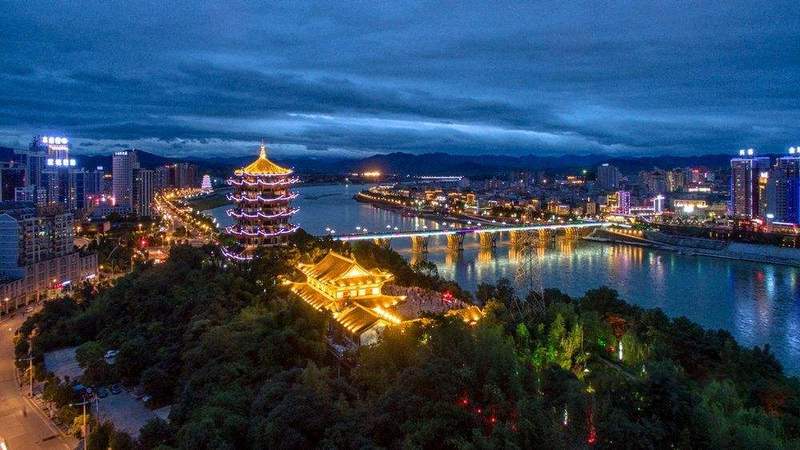Houliu Town, Houliu Ancient Town, Houliu Water Town, 3A Scenic Area. Located 18 kilometers south of Shiquan County along the Han River, it borders Chihe Town of this county to the east, Xihe Town to the south, Yundou Town of this county to the west, and Xixiang County to the west, and Chengguan Town to the north. Situated on the banks of the Han River, Houliu Town boasts expansive lakes and mountains, abundant natural resources, and a rich cultural heritage, resembling a beautiful ink painting. In 2016, Houliu Tourism Ancient Town received three consecutive honors: China's Rural Tourism Demonstration Village, one of Shaanxi Province's Top Ten Tourist Towns, and one of the Top Ten Boutique Homestays.
Yinghu Town
Yinghu Ecotourism Area is located at the foot of Tianzhu Mountain, 18 kilometers southwest of Ankang City. It is the largest freshwater artificial lake in the northwest region, formed after the completion of the Ankang Hydropower Station. Surrounding the ecotourism area is the Ankang Hydropower Station Dam, known as the 'First Dam of Shaanxi.' During flood discharge, the scene is thunderous and spectacular. On one side of the dam is the famous Buddhist site, Baiyun Temple on Tianzhu Mountain. Not far below the dam is a large steel cable-stayed bridge designed and built independently by China. Yinghu Lake is vast and beautiful, with islands scattered throughout, creating a picturesque scene. The lake is rich in aquatic products, producing high-value silverfish. Additionally, tea is produced on the lakeshore, with 'Ankang Silver Peak' Maojian tea being quite famous. The lake shore also produces abundant citrus fruits. Yinghu Lake is surrounded by mountains on all sides, with both wide and clean water areas and winding, meandering water scenes. The scenic area offers various services for tourists, including hand-rowed boats, pedal boats, and speedboats.
Guigu Ridge National Forest Park
The Guigu Ridge Scenic Area is named after the Chinese sage Guiguzi. Tang scholar Sima Zhen said in 'Shiji·Suoyin': 'Within the pass, there is Guiguzi, in Yunyang.' Tang dynasty historian Zhang Shoujie quoted Liu's words in his 'Shiji': 'Liu Bozhuang said, this Guigu, within the pass in Yunyang, not Yangcheng.' According to this, Yangcheng Guigu belonged to Han (state) at that time, and Qin (state) could not place it. According to the research of pre-Qin historians, the ancient village of Yunyang at the foot of Guigu Ridge in today's Shiquan County was located within the Hangu Pass of the Qin state, with a steep terrain. This is the ancient Yunyang within the pass, the place where the Qin king wanted to detain General Gan Mao, and also the place where Guiguzi lived during the Warring States period. 'Mr. Guigu' is recorded in the ancient Chinese collection of immortals 'Lu Yi Ji'. The Yun surname Wang family, starting from the Xuanyuan tradition, through Shang and Zhou, followed Laozi westward to the drifting sands. They returned to China last weekend and lived in Guigu Mountain in Hanbin.
Hanjiang Yanxiang Cave Ecotourism Area
Address: Hanjiang Yanxiang Cave Ecotourism Area, Yundou Town, Shiquan County, Ankang City
Yinghu Cuiping Island
Cuiping Island is one of the attractions of Yinghu Lake, featuring architecture primarily in the style of Suzhou gardens. Cuiping Island consists of three parts: the northern part is the large Yuqing Suspension Bridge, which is 161 meters long and connects to the lakeshore with four ancient pavilions towering in the air; the central part is the three-star Cuiping Villa, which can host large conferences, dining, and accommodation; the southern part is a botanical garden, planted with famous and high-quality flowers and trees from the Qinba region, bamboo groves, and fresh fruits. It is home to the 'dove tree,' known as a living fossil of plants, and a large area of cherry blossoms. Due to its spring-like climate year-round and lush greenery, it looks like a peacock spreading its tail when viewed from above, hence the name 'Cuiping Island.'









